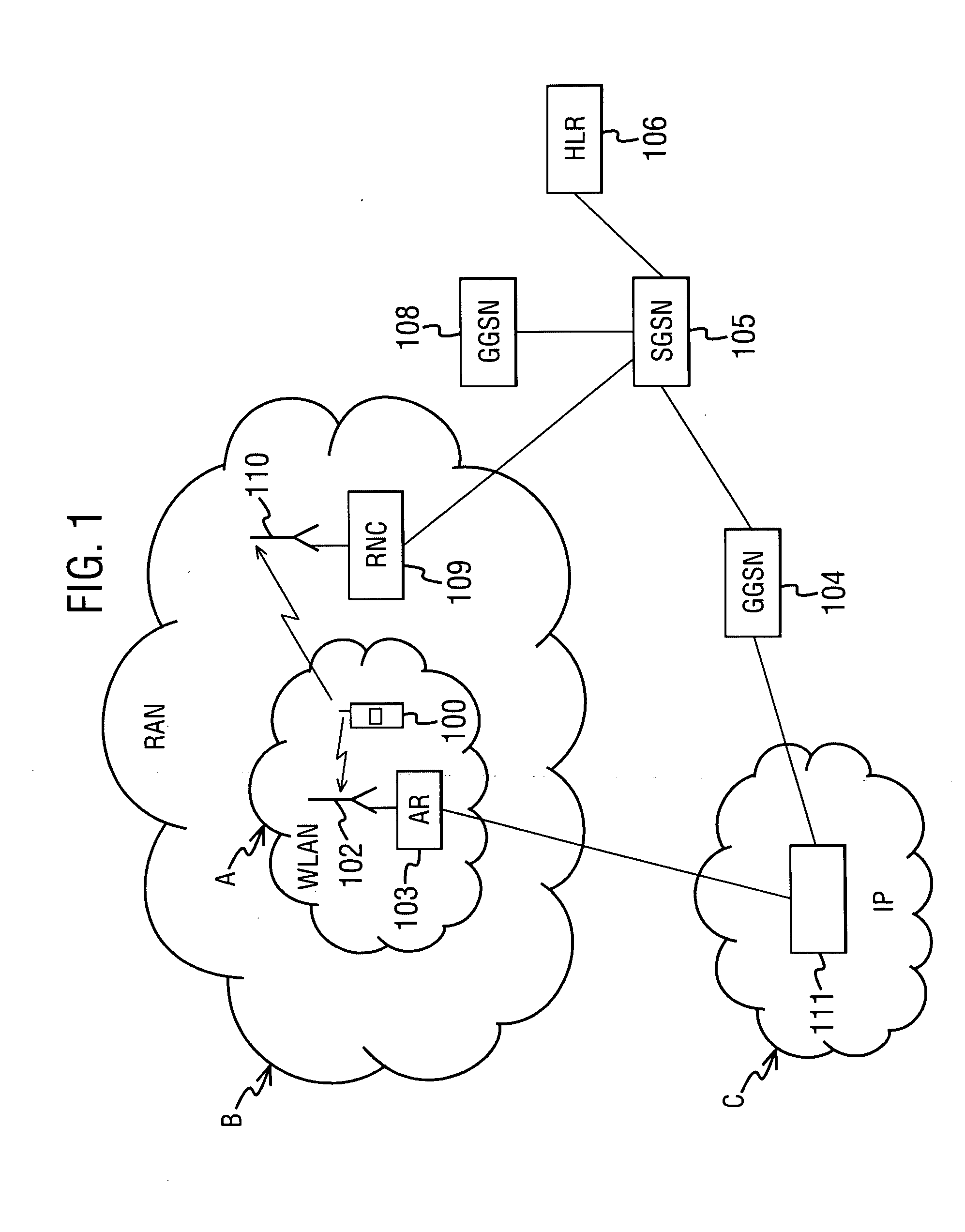Method for optimizing handover between communication networks
a communication network and handover technology, applied in the field of optimizing handover between communication networks, can solve problems such as inability to solve particular problems, disruption of ip sessions, and small overlap between signals from wlan and umts networks
- Summary
- Abstract
- Description
- Claims
- Application Information
AI Technical Summary
Benefits of technology
Problems solved by technology
Method used
Image
Examples
first embodiment
[0030]FIG. 1 illustrates a simplified presentation of the invention for handover between a WLAN network A and a GPRS network B.
[0031] In this example, the mobile node (MN) 100 is engaged in an IP communication session between the WLAN network A and the IP network C. The IP communication session is provided by, for example, a service provider 111. The MN 100 wirelessly receives and transmits signals from and to base station 102. There is an access router (AR) 103 for routing the signals from the base station 102 to the IP network C. If the MN now moves towards the GPRS network B and the IP communication session is to continue, the invention proposes that handover is accomplished while the MN 100 is still attached to the WLAN network A. Although FIG. 1 depicts the WLAN network A as completely within the GPRS network B, in an alternative embodiment, there may simply be an overlap between the two coverage areas. The GPRS network B may include a gateway GPRS support node (GGSN) 104, a se...
second embodiment
[0050]FIGS. 3 and 4 depict the invention. In this situation, the MN will be moving into the PS (packet switched) core network rather than being supposed to be attached to the PS core network (as in FIGS. 1 and 2).
[0051] In FIG. 3, a simplified presentation of the second embodiment of the invention is shown for handover between a WLAN network A as a GPRS network B. This FIG. 3 is substantially the same as FIG. 1 except that there is only a single GGSN 104 which is able to act as the AR 103 for the WLAN network A and can host the PDP contexts of the MN 100.
[0052] In FIG. 4, the SGSN 105 starts the authentication of the MN 100 by first obtaining the authentication parameters from the HLR 106 and then sending a Proxy Authentication and Ciphering Request message to the GGSN via the WLAN network. In FIGS. 3 and 4 the GGSN 104 acts as an AR 103 in the GPRS network B from the point of view of the MN and is capable of receiving a handover trigger indication from the WLAN network A. As menti...
third embodiment
[0091] According to the invention the MN remains attached to the GPRS network, i.e. the PDP contexts are maintained when the MN moves from the GPRS network to any other access network. Consequently, when the MN moves back to the GPRS network for a second time and subsequent times, it will not have to waste time performing attach, authentication and PDP context procedures so that the handover delay time can be reduced considerably.
[0092] The main disadvantage in maintaining the PDP contexts is that the PDP contexts may be considered to be invalid. This may occur if the ongoing applications running on the MN are completely different than those which the PDP contexts were originally activated for, i.e. the MN has moved from the GPRS network to another access network and has started to use different applications having other requirements before returning to the GPRS network. This may imply either a modification in the QoS requirements for the maintained PDP contexts or more drastically,...
PUM
 Login to View More
Login to View More Abstract
Description
Claims
Application Information
 Login to View More
Login to View More - R&D
- Intellectual Property
- Life Sciences
- Materials
- Tech Scout
- Unparalleled Data Quality
- Higher Quality Content
- 60% Fewer Hallucinations
Browse by: Latest US Patents, China's latest patents, Technical Efficacy Thesaurus, Application Domain, Technology Topic, Popular Technical Reports.
© 2025 PatSnap. All rights reserved.Legal|Privacy policy|Modern Slavery Act Transparency Statement|Sitemap|About US| Contact US: help@patsnap.com



